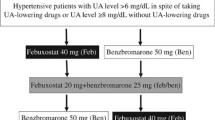Summary
When choosing antihypertensive agents for the treatment of hypertension, it is necessary to consider the predisposition of individuals to renal damage, which may be associated with the long-term effect of such agents. In this respect, this study examined the effect of two commonly used antihypertensive drugs (Brinerdin and Minizide) on renal function over 24 months in patients diagnosed as having essential hypertension. We utilized urinary enzyme studies, which are indicators of subtle renal dysfunction. Other parameters of glomerular and tubular function were also determined in the pretreatment period, as well as during and at the end of treatment of 28 patients (16 males and 12 females) with therapeutic doses of Brinerdin and 22 patients (12 males and 10 females) with conventional doses of Minizide. During the follow-up period, blood pressure (BP) fell from a mean of 160/108±9/4 (SD) mmHg to 130/90±7/4 on Brinerdin and from a mean of 160/106±5/2 (SD) mmHg to 130/90±8/5 on Minizide. There was no significant difference in the levels of BP between the patients taking Minizide and those taking Brinerdin before, during, and at the end of treatment. Significant elevation (p<0.05) of the levels of urinary protein, lactate dehydrogenase (LDH), and N-acetyl-B-D-glycosaminidase (NAG) was observed in patients on Minizide during treatment, and these levels remained elevated during the latter part of the study. Normotensive, untreated, age-and sex-matched control subjects showed no such urinary parameter changes. While NAG activity was significantly elevated in the Brinerdin-treated patients, other parameters remained within comparable levels to those of normotensive, untreated control subjects throughout the period of study. However, a significant reduction in the serum potassium level (−0.58±0.06 mmol/l) was observed following Minizide therapy compared with a mild reduction (−0.25±0.05 mmol/l) following Brinerdin treatment. Female and male patients exhibited similar patterns of response to the two drugs. The results of the present study suggest that transient but subtle tubular injury has been induced by the use of the two drugs with a more profound effect from the use of Minizide.
Similar content being viewed by others
References
Stokes GS, Gain JM, Mahony JF, Raftos J, Steward JH. Long-term use of prazosin in combination or alone for treating hypertension.Med J Austr 1977;2(Special Suppl):13–17.
Alcazar JM, Rodico JL, Ruilope LM. Long-term diuretic therapy and renal function in essential arterial hypertension.Am J Cardiol 1990;65:51H-54H.
Zhi-wen L, Li-sheng L. The value of captopril test and the effect of captopril on renal function.J Hum Hypertens 1992;4:138–140.
Obatomi DK. The Use of Urinary Enzymes to Detect Kidney Damage. PhD thesis, University of London, 1986.
Wellwood JM, Lovell D, Thompson AE, Tighe JR. Renal damage caused by gentamicin: A study of the effects on renal morphology and urinary enzyme secretion.J Pathol 1976;118:171–182.
Plummer DT, Noorazar S, Obatomi DK, Haslam JD. The assessment of renal injury by urinary enzymes.Uraemia Invest 1986;9:97–102.
Yuen CT, Price RG, Chattagoon L, Richardson AC, Praill PFG. Colorimetric assays for N-acetyl-B-D-glucosaminidase in human urine using newly developed W-nitrostyryl substrates.Clin Chim Acta 1982;124:195–204.
Obatomi DK, Olorunfemi JO, Jigam AA. Urinary enzyme activity in healthy Nigerian subjects.Med Sci Res 1992;20:117–118.
Obatomi DK, Jigam AA, Mogbo SCJ. Assessment of renal damage in patients with essential hypertension.Med Sci Res 1992;20:157–159.
Heinegard D, Tinderstrom G. Determination of serum creatinine by a direct colorimetric method.Clin Chim Acta 1973;43:305–309.
Plummer DT.An Introduction to Practical Biochemistry, 2nd ed. London: McGraw Hill, 1978:145.
Libermann LL. Standard methods in clinical chemistry.Clin Chem 1958;2:26–30.
Obatomi DK, Plummer DT, Haslam JD. Enzymuria as an index of nephrotoxicity over long-term exposure of rats to gentamicin. In: Bach PH, Gregg NJ, Wils MF, Delacruz L, eds.Nephrotoxicity, Mechanisms, Early Diagnosis and Therapeutic Managements. New York: Marcel Dekker, 1991:555–561.
Price RG. Urinary enzymes, nephrotoxicity and renal disease.Toxicology 1982;23:99–134.
Palmieri L, Ronco G, Gioni L, Puccini R. Enzymuria as a marker of renal injury and disease: Studies of N-acetyl-B-D-glucosaminidase, alanine aminopeptidase and lysozyme in patients with renal disease.Contrib Nephrol 1984;42:123–129.
Leonetti G, Rappelli A, Salvetti A, Scapellato L. Long-term effects of indapamide: Final results of a two-year Italian multicentre study in systemic hypertension.Am J Cardiol 1990;65:67H-71H.
Ledingham JGG. Disorders of potassium metabolism. In: Weatherall DJ, Ledingham JGG, Warrell DA, eds.Oxford Textbook of Medicine. Oxford: Oxford University Press, 1984:1828–1830.
Obatomi DK, Plummer DT. Influence of hydration states on the acute nephrotoxic effect of gentamicin in the rat.Toxicology 1993;80:141–152.
Author information
Authors and Affiliations
Rights and permissions
About this article
Cite this article
Obatomi, D.K., Mogbo, S.C.J., Anjorin, F.I. et al. Changes in urinary enzyme levels following the use of antihypertensive agents in patients with essential hypertension. Cardiovasc Drug Ther 9, 407–412 (1995). https://doi.org/10.1007/BF00879029
Received:
Accepted:
Issue Date:
DOI: https://doi.org/10.1007/BF00879029




